AROMA MISSION PHASE I & II SUCCESS STORIES
Catalyzing Rural Empowerment through Cultivation, Processing, Value Addition and Marketing of Aromatic Plants: CSIR-Aroma Mission interventions of CSIR-IIIM, Jammu
CSIR IIIM launched Aroma Mission in 2016 to increase the income of the farmers by the cultivation of plants with aromatic values. Some of the aromatic crops being cultivated under the Aroma mission include Lavender, Marigold, Lemongrass, Ocimum, Mint, Salvia, Rose, Rosemary and Rosagrass. The two phases of this mission have been successfully completed. The first phase of CSIR-Aroma Mission, launched on 1st April 2016 was completed on 31st March 2019 and the second phase of CSIR-Aroma Mission, launched on April 2020 was completed on March 2023. First and Second phase of CSIR-Aroma Mission has brought a transformative change in the aroma sector through scientific interventions in the area of agriculture, processing, and product development by fuelling the growth of the aroma industry and rural employment. Following the success of the two phases, Aroma Mission Phase-III has been approved under which the focus would be provided to farmers for value addition and product development. This had a great impact on inclusive economic development of the farmers and promotion of agri- tech start up ecosystem of the region. The following are some significant achievements of CSIR-IIIM during the first and second phase of the CSIR-Aroma Mission:-
- Bring about 14500 ha in Phase I and Phase II under captive cultivation aromatic cash crops particularly targeting rain-fed /degraded land across the country.
- Provided technical and infrastructural support for distillation and values-addition to farmers/growers all over the country.
- Enabled effective buy-back mechanisms to assure remunerative prices to the farmers/growers.
- Made progress in value-addition of essential oils and aroma ingredients for their integration in global trade and economy.
Promotion of cultivation and processing of aromatic crops and enhancing area of selected aromatic plants under CSIR-Aroma Mission
The total area of more than 1850 ha benefiting more than 2100 farmers has been bought under captive cultivation of selected aromatic crops at various locations throughout the country under CSIR-Aroma Mission by CSIR-IIIM, Jammu (Table 1 & Figure 1). Seven districts in Kashmir division viz., Bandipore, Baramulla, Budgam, Ganderbal, Kulgam, Kupwara, and Pulwama; Nine districts in Jammu division viz., Doda, Jammu, Kathua, Kishtwar, Rajouri, Ramban, Reasi, Samba and Udhampur; and two districts in Ladakh division viz., Kargil and Leh were covered under CSIR-Aroma Mission. Lavender, which was earlier disseminated in Kashmir valley by the institute, was now introduced to the temperate regions of Jammu as well. More than 600 farmers have taken up cultivation of Lavender on 150 ha area in J&K under CSIR-Aroma mission. Quality planting material (QPM) of Tagetes minuta was provided to the farmers in Kargil and Leh districts of the Ladakh division for the first time. Under CSIR-Aroma Mission, CSIR-IIIM has introduced selected aromatic crops to small and marginal farmers in remote border districts of J&K like Kupwara, Rajouri, Kargil, Jammu, Samba and Kathua where opportunities for employment are limited. QPM of the selected aromatic plants worth > 10 crores of market price was distributed free of cost to the farmers throughout the country. Till March 2020, it was estimated that these farmers produced > 12,500 kg essential oil worth > 3 crores by CSIR-Aroma Mission interventions of CSIR-IIIM, Jammu. Under first phase of CSIR-Aroma Mission, the selected aromatic crops have been successfully introduced to the small and marginal farmers at various locations of the country, which has helped in improving their socio-economic condition immensely.
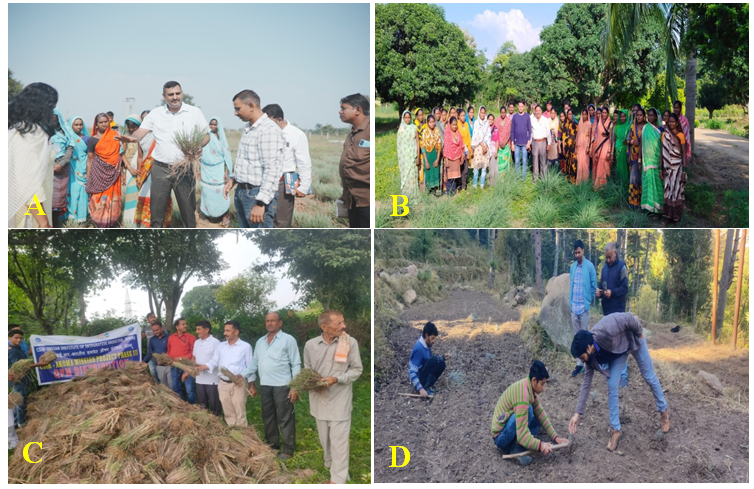
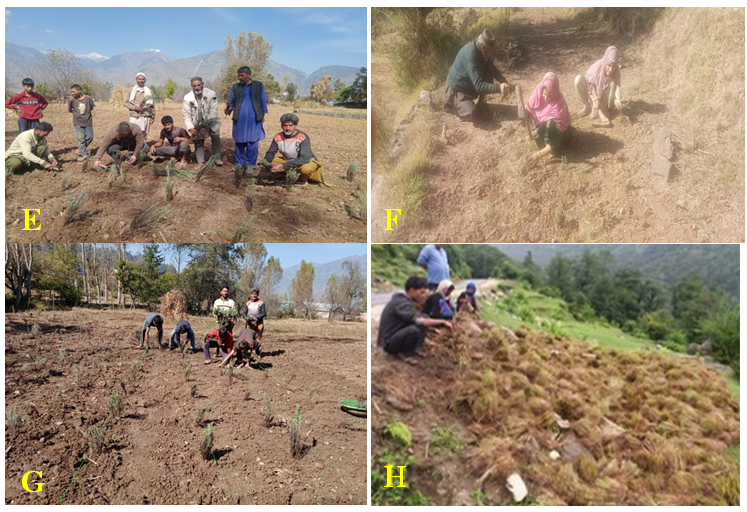
Figure 1: A) Lemongrass plantation at Gariaband, Chhattisgarh; B) Rosagrass plantation at Mahasamund, Chhattisgarh; C) Lavender plantation at Dansal, J&K D) Lavender plantation at Batote, J&K; E) Ocimum plantation at Kurma, Bhuj; F) Lavender plantation at Gool, J&K; G) Lavender plantation at Saangaldan,J&K; H) Ocimum plantation at Rajsamand, Rajasthan)
Table 1: More than 1850 ha area was brought under captive cultivation of following aromatic plants at various locations throughout country by CSIR-IIIM, Jammu under first phase of CSIR-Aroma Mission.
| Aromatic crop [Variety] |
States where crop is extended
|
|
Lavender [RRL-12]
|
J&K, Arunachal Pradesh, Himachal Pradesh
|
| Ocimum [RRL-OG-14, RRL-OB-15] | Tamil Nadu, Uttar Pradesh, Bihar, Rajasthan, Haryana, Chhattisgarh, Himachal Pradesh, Madhya Pradesh |
| Jammu Monarda [IIIM(J) MC-02] | Chhattisgarh, Haryana, J&K, Rajasthan, Uttar Pradesh, Ladakh |
| Rosagrass [RRL(J)CN-5, IIIM(J)CK-10 Himrosa] |
Andhra Pradesh, Chhattisgarh, Gujarat, Haryana, J&K, Karnataka, Madhya Pradesh, Maharashtra, Rajasthan, Tamil Nadu, Telangana, Uttar Pradesh, Uttarakhand
|
| Mentha [RRL(J)MT-94, RRL(J)ML-4] |
J&K, Ladakh
|
| Lemongrass [CKP-25, CPK-F2-38 Kalam] | J&K, Punjab, Haryana, Chhattisgarh, Uttar Pradesh, Uttarakhand |
| Geranium [PG-IIIM-101] |
J&K, Arunachal Pradesh
|
| Rosemary |
J&K
|
| Tagetus minuta | J&K, Ladakh |
| Salvia sclarea | J&K, Ladakh |
Table 2: Locations and types of the distillation units installed under CSIR-Aroma Mission throughout India.
| State | District | Type of Distillation Unit | Capacity |
No. of units
|
| Madhya Pradesh | Chhindwara | SS FDU | 500 kg | 1 |
| Sagar | MS FDU | 500 kg | 1 | |
| Karnataka | Mysore | MS FDU | 500 kg | 1 |
|
Bihar
|
Aurangabad | MS FDU | 500 kg | 1 |
|
Chhattisgarh
|
Raipur | MS FDU | 500 kg | 1 |
| Gujarat | Jamnagar | SS FDU | 500 kg | 1 |
|
Maharashtra
|
Jalna | SS FDU | 500 kg | 1 |
|
Rajasthan
|
Karauli | MS FDU | 500 kg | 1 |
|
Tamil Nadu
|
Pudukkottai | SS FDU | 500 kg | 1 |
|
Telangana
|
Hyderabad | SS FDU | 500 kg | 1 |
| Uttar Pradesh | Sultanpur | MS FDU | 500 kg | 1 |
| UT of Ladakh | Kargil | SS FDU | 500 kg | 1 |
| Zanskar | SS FDU | 500 kg | 1 | |
| UT of Jammu & Kashmir | Anantnag | SS FDU | 500 kg | 2 |
| Bandipora | SS FDU | 500 kg | 1 | |
| Budgam | SS FDU | 500 kg | 3 | |
| Doda | SS FDU | 500 kg | 3 | |
| MS FDU | 500 kg | 1 | ||
| Ganderbal | SS FDU | 500 kg | 1 | |
| Jammu | SS FDU | 500 kg | 4 | |
| SS Mobile unit | 500 kg | 4 | ||
| MS FDU | 500 kg | 1 | ||
| SS Cohabition unit | 500 kg | 2 | ||
| Kathua | SS FDU | 500 kg | 3 | |
| MS FDU | 500 kg | 1 | ||
| Kishtwar | SS FDU | 500 kg | 1 | |
| Kupwara | SS FDU | 500 kg | 3 | |
| Pulwama | SS FDU | 500 kg | 2 | |
| MS FDU | 500 kg | 10 | ||
| SS Cohabition unit | 500 kg | 2 | ||
| Rajouri | MS FDU | 500 kg | 1 | |
| Reasi | MS FDU | 500 kg | 1 | |
| Srinagar | SS FDU | 500 kg | 1 | |
| Udhampur | SS FDU | 500 kg | 1 | |
| Total | 61 |
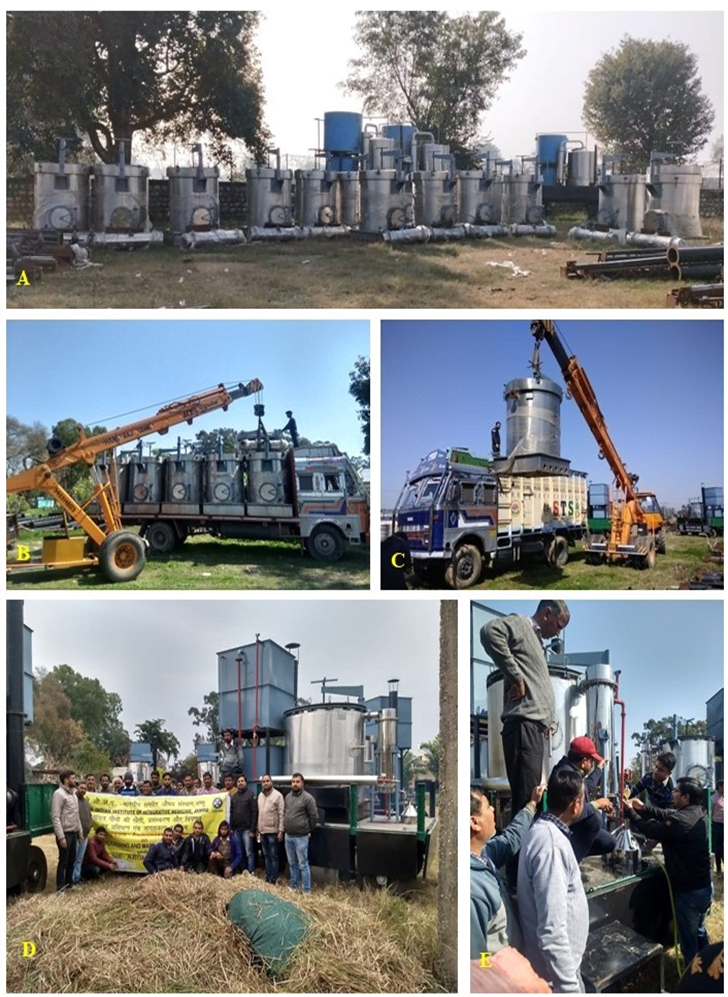
Figure 2: Transportation and installation of fixed and mobile Distillation Units under CSIR-Aroma Mission.
Skill development and product development activities under CSIR-Aroma Mission
Aromatic plants are suitable economic alternates for achieving higher income and utilizing marginal/problematic lands and can also act as insurance crops in the event of environment/climate excesses. Under the CSIR-Aroma Mission, a total of 124 awareness-cum-training programs were conducted for the growers and other stakeholders, particularly in the regions where farmers are adversely hit by the deficient/excessive rainfalls (Table 3). Fifty-two awareness-cum-training programs were conducted at different locations during the year 2019-20. Experts from industries and financial institutions were also involved in training growers of various schemes for obtaining financial help (Figure 3). Selected progressive farmers/ young entrepreneurs were also trained in distillation, fractionation/derivatization, extraction, quality control, product development, etc. Videos on the successful introduction and cultivation of aromatic plants and activities of CSIR-Aroma Mission were developed and released. Products such as Lavender face wash, Citronella & Lemongrass based mosquito repellent, and Lavender oil-based travellers kits were developed along with prototypes for many other essential oil based products. For making the public aware of CSIR-Aroma Mission activities and achievements using the appropriate interface, booklet entitled “CSIR Aroma Mission Booklet entitled “Catalyzing Rural Empowerment through Cultivation, Processing, Value Addition and Marketing of Aromatic Plants” was designed, published and distributed.
Table 3: Details of state wise awareness-cum-training programme conducted under CSIR-Aroma Mission by CSIR-IIIM, Jammu.
| State | Type of Training (No. of days) |
No. of Program
|
|
Arunachal Pradesh
|
Advanced (Three days) | 1 |
| Chhattisgarh | Awareness (One day) | 1 |
| Gujarat | Advanced (Two days) | 1 |
|
Haryana
|
Awareness (One day) | 1 |
| Jammu and Kashmir + Ladakh | Advanced (Two days) | 2 |
| Awareness (One day) | 60 | |
| Training (One month) | 1 | |
|
Karnataka
|
Awareness (One day) | 2 |
| Advance (two days) | 1 | |
| Madhya Pradesh | Awareness (One day) | 7 |
| Maharashtra | Advanced (Three days) | 1 |
| Awareness (One day) | 6 | |
| Punjab | Awareness (One day) | 2 |
| Rajasthan | Awareness (One day) | 18 |
| Tamil Nadu | Awareness (One day) |
2
|
|
Uttar Pradesh
|
Advanced (One week) | 2 |
|
Awareness (One day)
|
16 | |
|
Total
|
124 |
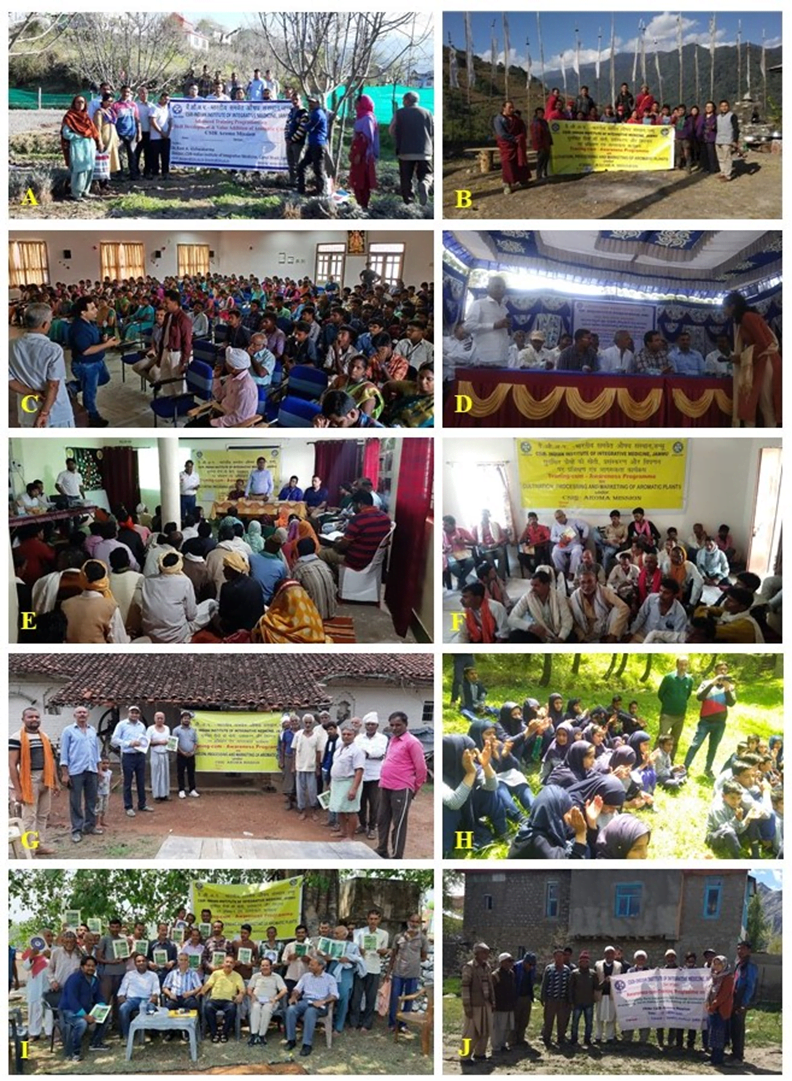
Figure 3: Awareness-cum-training programme under CSIR-Aroma Mission at A) Dodda, J&K; B) Kalaktang, Arunachal Pradesh; C) Puddukkotai, Tamil Nadu; D) Mysore, Karnataka; E) Chhindwara, Madhya Pradesh; F) Rajsamand, Rajasthan; G) Rewa, Madhya Pradesh; H) Verinag, J&K; I) Jammu, J&K; J) Kargil, Ladakh
Successful cultivation of the high-value Lavender crop in Jammu division of UT of J&K, India
Lavandula angustifolia Mill. (Syn. L. officinalis Chaix) or “True Lavender” is a small, non-hardy perennial evergreen subshrub belonging to the family Lamiaceae. The genus Lavandula comprises many important species that are geographically distributed in Mediterranean countries, Canary Islands and India. It is commercially cultivated in many parts of the world, mainly for its essential oil, which is obtained by the hydro-distillation of its attractive flowering spikes. Lavender is commercially one of the best known essential oil-bearing plants, which is grown for essential oil and dry flowers. Lavender oil mainly consists of linalyl acetate, linalool, lavandulol, 1-8-cineole, lavandulyl acetate, and camphor. Because of its delightful odour, Lavender oil has found wide applications in flavour, perfumery and cosmetic industry. Linalool and linalyl acetate contents in Lavender oil are used as the criterion for its quality evaluation. It is also used in therapeutics as antispasmodic, and carminative. Recently, as aromatherapy has become increasingly popular, Lavender oil has found application as a stress buster or brain relaxant.
The global demand for Lavender oil is estimated at around 12000 tons/year, whereas domestic consumption of Lavender oil is more than 250 tons/year. Internationally the primary producers of Lavender oil are Bulgaria, France, the United Kingdom, Spain, China, Russia, Italy, Morocco, countries of the former Yugoslavia, Hungary, Romania, Poland, Turkey, Ukraine, Moldova, South Africa, and the USA. In India, Lavender was first introduced in the Kashmir Valley in the year 1983, where its commercial cultivation was found to be successful. Lavender growing in the mountains of Jammu & Kashmir (J&K) produces an outstanding quality of Lavender oil. Low production costs and superior quality essential oil coupled with high market demand have made Lavender cultivation very profitable and famous in J&K. After the successful cultivation of Lavender in the Kashmir division, CSIR-IIIM, Jammu has introduced and tried to popularize Lavender in the temperate regions of the Jammu division under CSIR-Aroma Mission.
Under CSIR-Aroma Mission, high value essential oil-bearing Lavender crop was introduced to the farmers of temperate regions of Jammu viz., Doda, Kishtwar, and Rajouri districts. Till March 2021 under CSIR-Aroma Mission, Quality planting material (QPM) of Lavender, i.e., more than 8 lakh rooted plants of Lavender were provided free of cost to more than 500 farmers in the Jammu region for >140 acres of land. Besides free QPM of Lavender, free technical knowledge and essential oil distillation facilities were provided to the farmers. Field demonstration for plantation of Lavender was also given to the farmers. Detailed information about agro-technology and field management practices was provided to the farmers. Lavender cultivation in the Jammu division is immensely helping in alleviating the income of the marginal farmers of the region. Lavender has become vastly popular among small and marginal farmers of the temperate regions of the Jammu division. Farmers have produced more than 800 liters of lavender oil worth Rs. Eighty lakhs between years 2018-2020
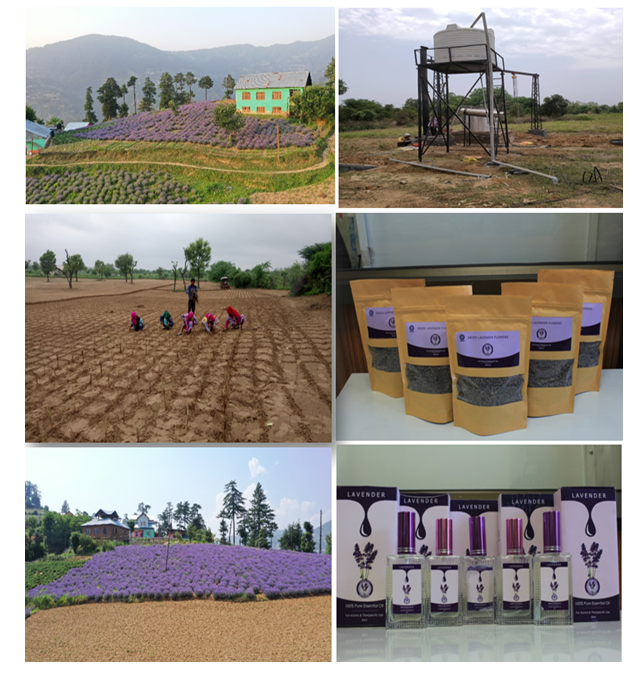
Figure 1: Lavender plantation at different locations of the Jammu division, dried flower and essential oil of lavender.

English Hindi Urdu-
Twitter
-
Facebook